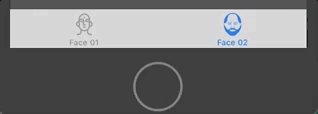In my Swift app I have this class that handles a UITabBar.
class CustomTabBar: UITabBar {
override func awakeFromNib() {
super.awakeFromNib()
}
}
How can I animate the items when the user tap their?
I mean a CGAffine(scaleX: 1.1, y: 1.1)
So how I can animate the tab bar's items?
UITabBarController as follows:
import UIKit
enum TabbarItemTag: Int {
case firstViewController = 101
case secondViewConroller = 102
}
class CustomTabBarController: UITabBarController {
var firstTabbarItemImageView: UIImageView!
var secondTabbarItemImageView: UIImageView!
override func viewDidLoad() {
super.viewDidLoad()
let firstItemView = tabBar.subviews.first!
firstTabbarItemImageView = firstItemView.subviews.first as? UIImageView
firstTabbarItemImageView.contentMode = .center
let secondItemView = self.tabBar.subviews[1]
self.secondTabbarItemImageView = secondItemView.subviews.first as? UIImageView
self.secondTabbarItemImageView.contentMode = .center
}
private func animate(_ imageView: UIImageView) {
UIView.animate(withDuration: 0.1, animations: {
imageView.transform = CGAffineTransform(scaleX: 1.25, y: 1.25)
}) { _ in
UIView.animate(withDuration: 0.25, delay: 0.0, usingSpringWithDamping: 0.5, initialSpringVelocity: 3.0, options: .curveEaseInOut, animations: {
imageView.transform = CGAffineTransform(scaleX: 1.0, y: 1.0)
}, completion: nil)
}
}
override func tabBar(_ tabBar: UITabBar, didSelect item: UITabBarItem) {
guard let tabbarItemTag = TabbarItemTag(rawValue: item.tag) else {
return
}
switch tabbarItemTag {
case .firstViewController:
animate(firstTabbarItemImageView)
case .secondViewConroller:
animate(secondTabbarItemImageView)
}
}
}
tag values for the tabBarItem for each view controller:
First ViewController:
import UIKit
class FirstViewController: UIViewController {
override func viewDidLoad() {
super.viewDidLoad()
tabBarItem.tag = TabbarItemTag.firstViewController.rawValue
}
}
Second ViewController:
import UIKit
class SecondViewController: UIViewController {
override func viewDidLoad() {
super.viewDidLoad()
tabBarItem.tag = TabbarItemTag.secondViewConroller.rawValue
}
}
Make sure that everything has been setup with your storyboard (if you are using one) and that's pretty much it!
Output:

You could check the repo:
https://github.com/AhmadFayyas/Animated-TabbarItem/tree/master
for demonstrating the answer.
This do the trick for me:
class MyCustomTabController: UITabBarController {
override func tabBar(_ tabBar: UITabBar, didSelect item: UITabBarItem) {
guard let barItemView = item.value(forKey: "view") as? UIView else { return }
let timeInterval: TimeInterval = 0.3
let propertyAnimator = UIViewPropertyAnimator(duration: timeInterval, dampingRatio: 0.5) {
barItemView.transform = CGAffineTransform.identity.scaledBy(x: 0.9, y: 0.9)
}
propertyAnimator.addAnimations({ barItemView.transform = .identity }, delayFactor: CGFloat(timeInterval))
propertyAnimator.startAnimation()
}
}
As UITabBarItem is not a UIView subclass, but an NSObject subclass instead, there is no direct way to animate an item when tapped.
You either have to dig up the UIView that belongs to the item and animate that, or create a custom tab bar.
Here are some ideas for digging up the UIView. And here for example how to get triggered when an item is tapped. But be very careful with this approach:
UITabBar implementation, which could break this.By the way, there's no need to subclass UITabBar. Implementing UITabBarDelegate is all you'd need.
I would actually advise you to just stick with the standard UITabBar behaviour & skinning options, and figure this out later or not at all. Things like this can burn your time without adding much to the app.
If you love us? You can donate to us via Paypal or buy me a coffee so we can maintain and grow! Thank you!
Donate Us With